Tag: mindful leadership
Why Employee Engagement and Enablement?
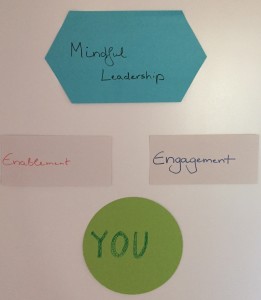 Competitive companies nowadays face an enormous pressure and so do their employees. Today’s best leaders have the resilience to cope with the many challenges and uncertainties coming their way and the resolve to sustain long-term success. Where does this resilience come from?
Competitive companies nowadays face an enormous pressure and so do their employees. Today’s best leaders have the resilience to cope with the many challenges and uncertainties coming their way and the resolve to sustain long-term success. Where does this resilience come from?
Well, from focus and clarity on one hand while making important decisions, then from creativity while transforming their enterprises, compassion for their employees and customers and lastly of course from courage to go their own way.
Studies conducted by companies evaluating their own executives have proven that the top 10% of performers displayed superior competencies in what is called, emotional intelligence, rather than in purely cognitive thinking. Capabilities like self-confidence and initiative; bouncing back from setbacks and staying cool under stress; empathy and powerful communication, collaboration; and teamwork all make for better business results.
Of course, when people feel motivated they perform better. High levels of employee engagement can for example boost revenue growth by up to 2.5 times!
But employee engagement is only half of the story. It’s not enough feeling great about your job if you cannot get things done. That’s why it is important for employees to be “enabled” too.
And exactly for that reason, the focus lies on you, your capacity to motivate your teams, engage and enable them. You become actors as well as owners of a sustainable future within your organisation or company by embodying change and people focus. Walk the talk and your employees will follow!
“If your actions inspire others to dream more, learn more, do more and become more, you are a leader.” John Quincy Adams
The Secret of Interpersonal Communication
Becoming an effective communicator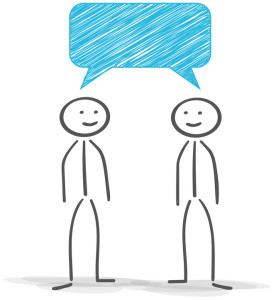
I am sure that you have already attended a communications training of some sort in your life; be it to improve your communication skills, your team collaboration or to learn particular tools and methods that were supposed to enable you to become a better, more effective communicator.
As I wrote in an earlier post, communications is much more than its mere verbal aspect let alone a set of tools and measures:
Following a study of Albert Mehrabian, an American Psychologist, who looked into which aspects of communications are relevant to the actual understanding of information thus to effectively communicating:
- The verbal aspect only accounts for 7 % (hence the content of what you are saying)
- 38 % come from the paraverbal aspect of communication (intonation, cadence, volume or pace ) and surely not surprising:
- 55 % from the non-verbal aspects.
 Over the last weekend, I have been exploring a technique called “Insight Dialogue” which was recommended to me and really is mindfulness and awareness applied to interpersonal communications. While you pause and relax, you provide yourself with the opportunity to tune into your own feelings and emotions, stepping out of the habitual trigger-response mechanism and opening up, allowing (mutual) space for response rather than reactivity. While you trust what emerges and listen deeply, you finally propose an answer or input, which is truly beneficial to your counterpart or dialogue partners. You remain integer and compassionate not being entangled in emotions or feelings and clinging to words wanting to steer the conversation your way.
Over the last weekend, I have been exploring a technique called “Insight Dialogue” which was recommended to me and really is mindfulness and awareness applied to interpersonal communications. While you pause and relax, you provide yourself with the opportunity to tune into your own feelings and emotions, stepping out of the habitual trigger-response mechanism and opening up, allowing (mutual) space for response rather than reactivity. While you trust what emerges and listen deeply, you finally propose an answer or input, which is truly beneficial to your counterpart or dialogue partners. You remain integer and compassionate not being entangled in emotions or feelings and clinging to words wanting to steer the conversation your way.
What a great way of connecting with each other and having a meaningful conversation. I am now even more passionate about including these techniques into my training, coaching and consulting work. Insight Dialogue certainly offers a wonderful way towards working on Self-Awareness and Management, Social Awareness and Relationship-Management all at the Center of Emotional Intelligence thus at the heart of Mindful Leadership.
Linking Mindfulness to Sports and Intercultural Training
Leadership, Diversity and Mindfulness applied to sports
Last Saturday at the SIETAR Europa conference, I had the chance to animate a wonderful workshop with a fellow interculturalist and friend Susan Salzbrenner from Fit Across Cultures. 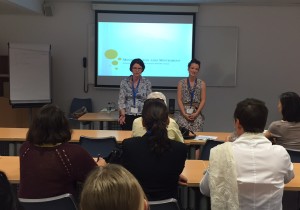 As we both have a strong background in sports and did not want to engage in more theories and “brain” focused presentations and activities, we decided to animate a session connecting our two brains[1]: the cranial one which we know and the so-called “enteric brain” located in our bellies (in the gut).
As we both have a strong background in sports and did not want to engage in more theories and “brain” focused presentations and activities, we decided to animate a session connecting our two brains[1]: the cranial one which we know and the so-called “enteric brain” located in our bellies (in the gut).
How did we do that?
Well, by linking intercultural training and the importance of “embodiment[2]” and mindfulness (moment to moment awareness) to athlete’s realities and movement. After a moment of mindful walking and grounding and by means of a very practical “experiment” we had the participants tune into themselves and connect with their feelings and body experience in different challenging intercultural and interpersonal situations.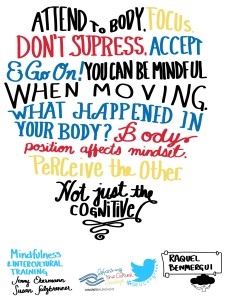
Although this is far from being easy, the participants were wonderful and shared what was going on for them. Being able to relate to your bodily experience can actually inform you even before your thoughts come in, when it comes to decisions, dealing with particular emotional situations or simply in our daily lives. In the context of sports, athletes also have to train mentally in order to be able to resist pressure in competitions and perform at their best. Being in sync with their bodies helps them to overcome differences and difficult situations and enables diverse teams – when managed well – to outperform competitors.
What a great learning and what a powerful group! Thanks to all of you who have participated and thanks Raquel Benmergui for the wonderful graphic representations!
Jenny
[1] Compare to : Amnon Buchbinder on Philip Shepherd’s “Out of our heads”
[2] In the sense that: “We make the experience of culture through our bodies”, see Ida Castiglioni: “Embodiment of Culture”
Do you still read books?
 How many people among you still read books? Or do you prefer reading your favourite magazines and authors on mobile devices? I must say that I still love holding a hard copy in my hands that I can feel, smell, touch…. Especially when entering an old library and imagining all the work that went into writing, drawing, updating the manuscripts and books, I feel very humble and at the same time interested and eager to sit down and sink into this atmosphere of knowledge, fantasy, thoughts….
How many people among you still read books? Or do you prefer reading your favourite magazines and authors on mobile devices? I must say that I still love holding a hard copy in my hands that I can feel, smell, touch…. Especially when entering an old library and imagining all the work that went into writing, drawing, updating the manuscripts and books, I feel very humble and at the same time interested and eager to sit down and sink into this atmosphere of knowledge, fantasy, thoughts….
Today, we are living in a digital world, where everybody can share everything, become a journalist, producer, filmmaker right out of their living room and live wherever they might be. Children already start having touch pads and smart phones from a very young age onwards and not many of them have actually seen a library from the inside.
 Do they have to? No, I guess… it all depends on how you consume digital media, how much space you leave for just being and opening up for creativity and innovation.
Do they have to? No, I guess… it all depends on how you consume digital media, how much space you leave for just being and opening up for creativity and innovation.
As I travel through Europe and work with people from many different backgrounds and industries, I notice the same pattern: people feel overwhelmed, not “human” anymore, constantly reminded that they should be responding, checking, scrolling, informing, texting… you find people sitting in restaurants, tubes, buses, bars that don’t speak to each other but prefer sending out messages to their online “friends”. News, pictures, videos are volatile, replaced by a stream of newer, nicer, cooler images and texts every second. Social media spread information mostly without checking if the source of the information is actually credible.
Are you also constantly connected, on the run, hasting through your different activities?
Do you jump up, every time you hear the familiar ‘ping’ sound of your mobile device, indicating that something new came in even when it’s your neighbours phone or device?
Try this: switch off your ring tones, alarms and notices so that you don’t hear anymore when new messages come in! You will already feel somewhat more at ease.
Maybe you are even able to switch off your complete phone or tablet from time to time to allow yourself a brain break.
What do you think and how do you cope?
Jenny

Empowering Women and Minorities for Leadership Positions
Creating Value – Embracing Diversity – Leading Mindfully
Context and current situation :
Although in the EU women make up nearly half the workforce and more than half of new university graduates, they are still under-represented in top leadership positions. And this not only applies to women: minorities are also hardly represented at top management levels, although demographics indicate that a diverse workforce is definitely needed in order to maintain current living standards and sustainable growth.
Change is already on its way :
One of the founding principles of the European Union is the equality of women and men. According to a Europe 2020 initiative, policy options for targeted measures to enhance female participation in decision-making at the European level will be implemented, forty percent of top leadership positions are to be held by women. In a number of European countries important steps have already been taken to support women on their path towards leadership positions. In March 2015, Germany decided to introduce a women quota: by 2016, thirty percent of board members have to be female.
However, a quota and targeting women alone is not enough. Minorities also have a role to play as Europe sees more emigration and immigration. What is more, qualifying, training and developing competent women and minorities will not happen over night. Additionally, men will also need to be included in this change towards more diversity.
This is exactly where we come into play:
We are convinced that all these efforts ultimately have one goal: managing future challenges by embracing diversity within companies and society as such. We simply cannot afford, not to utilise important resources – no matter whether they are women, minorities or older people.
On the other hand, our world is increasingly volatile, ambiguous, uncertain and complex. Looking at systems in a more holistic way, using all available resources therefore becomes a MUST! Emotional intelligence, mutual trust, empathy and mindful leadership will be key in this process in order to achieve sustainable goals, grow as individuals and organisations and mange future challenges.
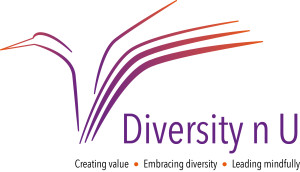 I have recently teamed up with Sabine Chmielewski to build DiversitynU.com, tackling the challenges of the 21st century. We value humans first and believe that the secret lies in realising the enormous potential we all have.
I have recently teamed up with Sabine Chmielewski to build DiversitynU.com, tackling the challenges of the 21st century. We value humans first and believe that the secret lies in realising the enormous potential we all have.
What an exciting journey! Stay tuned and contact me to learn more or to ask for help/an offer.
Jenny
How big are your windows?
 I hope you all enjoyed a lovely break over Easter! While spring is slowly coming in – at least in this part of the world – I found this Eskimo quote, which I would like to share with you:
I hope you all enjoyed a lovely break over Easter! While spring is slowly coming in – at least in this part of the world – I found this Eskimo quote, which I would like to share with you:
“Don’t let the windows of your home be so small that the light of the sun cannot enter your rooms.” (found here)
Have a great rest of the week and stay tuned for more posts on mindful leadership, diversity and intercultural communications! Jenny
Employers: Time to use your Untapped Potential!
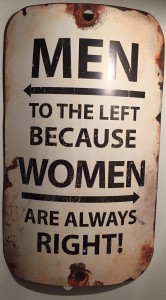 Yesterday while trying to find my way to the bathroom in a restaurant, I stumbled upon this sign…. While it made me laugh, it also made me wonder about the various initiatives targeting women that are currently under way to ensure more diversity in companies, equal pay and related issues.
Yesterday while trying to find my way to the bathroom in a restaurant, I stumbled upon this sign…. While it made me laugh, it also made me wonder about the various initiatives targeting women that are currently under way to ensure more diversity in companies, equal pay and related issues.
Not only the European Union with its 2020 priorities, but also the UN with the “He for She” initiative are embracing the issue of gender equality encompassing better access to employment and education. Many governments are also taking action by enforcing thresholds for women on boards, only recently to be followed in Germany.
Looking at the demographics for Europe, we believe that it is time for companies to use so far nearly untapped potential, meaning bringing not only women onboard and into leadership positions but also minorities and qualified migrants. Diversity gets a broader meaning and won’t be a nice slogan in some mission statement anymore. The capacity to attract a motivated and diverse workforce by offering them a flexible, sustainable work environment where they can co-create, be treated equally, have a chance to grow and use their creativity, in short get a sense of fulfillment is a must for any company nowadays.
Following a mindfulness based approach to leadership, training, coaching and consulting, we further believe that emotional intelligence is a key ingredient to personal development, team building and leadership development alike. Mutual trust, emotional intelligence, empathy and mindfulness are needed to achieving goals, developing further as an individual or an organisation and engaging in change.
Do you agree with us? Or maybe not? We would be happy to hear from you…
Have a great weekend!
Jenny
Trusting Emergence

In order to move through the world with curiosity, sensitivity and closely attuned to your environment, being able to trust emergence and letting go into the change process is key.
Gregory Kramer has the right words for this and I invite you to think about it over the weekend:
As you let go of plans, you are perched on the edge of possibility. Let the reminder to Trust Emergence arouse curiosity. What is happening now? Feel the truth of contingency and let it pull you out of any comfortable certainty. Attune to the unfolding moment and let your mind become nonresistive and pliable; let it move with experience. You can’t predict what someone will say, what will happen tomorrow. So you are waiting, relaxed in expectancy. Dwell in the moment lightly, with patience. If the mind wants to run ahead, to figure things out, remind yourself of the unpredictability of things. Let all plans fall away. Ride the moment. Locate the wisdom in not knowing. This leaves you open to anything, and not fearing change. Trust Emergence. – Insight Dialogue, page143
Jenny
Perceptions: Road Blocks or Stepping Stones
 The recent global events as well as a blog post from Dr. Milton Bennett about tolerance makes me think along the following lines: all humans have an automatic tendency to judge their own experiences.
The recent global events as well as a blog post from Dr. Milton Bennett about tolerance makes me think along the following lines: all humans have an automatic tendency to judge their own experiences.
Instead of simply noticing what is there in the present moment, unfolding and happening, we think about what needs to be changed, how things could or should be different. Something is not quite right in a way, not good enough, not what we had expected and wanted.
Often these thoughts will take us, quite automatically, down on some fairly well-worn paths in our minds. In this way, we lose awareness of the present moment and the ability to freely choose if and how to react. We jump quickly on to conclusions, which seem to be the right ones and by doing so, trigger behaviors and actions from ourselves and others around us.
Relating to the idea of tolerance we might want to ask ourselves where our threshold lies.
- How do we really feel deep inside us?
- What type of experiences deplete us and which ones make us happy?
- Where do we feel comfortable and where uncomfortable?
We can regain our freedom from automatic thoughts and reactions, if as a first step we simply acknowledge the actuality of the situation we find ourselves in, without being automatically hooked into tendencies to judge, fix, or want things to be different from the way they are.
How do we do this?
- Notice what is going on
- How did your body feel in detail during the experience?
- What thoughts and images accompanied the experience?
- What moods, feelings and emotions accompanied the event?
- Explore the effects of bringing awareness to the direct experience
- What do you notice?
- Is your mind wandering away?
- Is bringing awareness to the experience affecting it in a way? If so, how?
- Accept what is there without wanting to change anything
- Let go and simply acknowledge the arising and passing of emotions and thoughts without becoming entangled in the content of it.
Next time you’re confronted with a pleasant or unpleasant experience, try writing down what happened especially in steps 1 and 2. Exploring our own sensations, limits, beliefs, emotions, moods and thoughts is not easy and change doesn’t come over night. It comes with a lot of training and attention.
And of course, change starts with yourself and with how you experience and react to a situation and not with other people around you!

